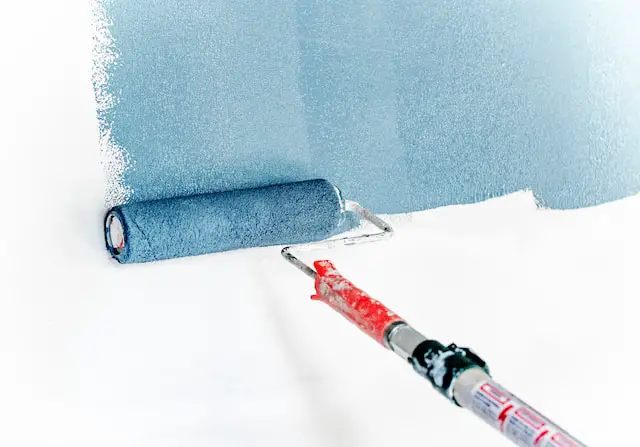Trim paint is a type of paint used for the finer details of a room, such as baseboards, window frames, and doorframes. Wall paint is used for painting the larger surfaces of walls and ceilings. Trim paint is typically more durable and glossier than wall paint.
What is Trim Paint?
(Photo by Ksenia Chernaya)

Trim paint is a type of paint specifically designed for use on trim, molding, doors, and other woodwork. It’s usually oil-based or hybrid (water and oil based) with polyurethane added to make it more durable than wall paint.
One of the key differences between trim paint and wall paint is its thickness – trim paints are thicker than wall paints, which makes them easier to control when painting intricate details like crown moldings or baseboards.
Trim paints come in many finishes such as gloss, semi-gloss, satin or matte depending on personal preference but also dependant on where it will be used. Glossier paints are ideal for high traffic areas because they provide better durability while matte finish can camouflage imperfections better.
Another advantage of using trim paint is that it dries faster than other types of paint so you can apply multiple coats quickly without waiting too long in between applications. Additionally, due to their tough nature against scuffing and staining , they work great in rooms that receive heavy use like hallways.
If you want your trims to have an elegant look that lasts longer then opting for a good quality Trim Paint should be your go-to choice!
What is Wall Paint?
(Photo by Kenny Eliason on Unsplash )

Wall paint is a type of paint that is specifically designed to be applied on walls. It is usually used to add color, texture and protection to interior or exterior walls. Wall paints come in different colours, finishes, and textures such as matte, glossy, eggshell or satin finish.
Wall paint can be made from different materials like oil-based or water-based chemicals. Some wall paints are formulated with special features such as mildew resistance and fire retardation properties.
Applying wall paint requires the use of various painting tools like brushes, rollers or sprayers depending on the surface you are dealing with. Before painting your walls it’s important to clean them thoroughly so that the new coat adheres well and delivers a smooth finish.
Choosing the right type of wall paint can also depend on factors such as whether it will be for high traffic rooms where durability should be considered over aesthetics; which colors complement furnishings best; weather conditions if painting exterior surfaces etc.
Wall paint serves an essential role in enhancing the appearance of our homes while providing protection against wear and tear.
Trim Paint Vs. Wall Paint – Key differences
Trim paint and wall paint are two different types of paints that serve different purposes. The main difference between the two is their consistency and formulation, which makes them suitable for specific applications.
Trim paint is a type of interior or exterior oil-based enamel used for painting baseboards, window trims, doors, and other decorative elements in your home. It typically dries to a hard finish and has excellent durability against wear and tear caused by everyday use.
Wall paint or interior paint is designed specifically for walls. It comes in various formulations such as latex, acrylic, or oil-based paints that can be applied with brushes or rollers. Unlike trim paint, wall paint generally has less sheen or glossiness to achieve a smooth finish on large surfaces like walls.
The key differences between trim paint vs. wall paint lie in their coverage ability, durability, and sheen level. Trim paints have better coverage than wall paints due to their thicker consistency while providing an exceptional glossy finish that adds texture to your home décor.
On the other hand, wall paints are formulated to provide maximum washability without compromising its color stability over time compared to trim paints’ more durable finishes.
Understanding the differences between trim painting Vs.wall painting can help you choose the right product when completing any home renovation project effectively.
When to Use Trim Paint vs. Wall Paint
When it comes to painting the interior of your home, choosing the right type of paint is crucial. If you’re wondering when to use trim paint versus wall paint, here are some key factors to consider.
Trim paint is typically used for the baseboards, door frames, window casings and other moldings in a room. It’s usually glossier and more durable than wall paint, which makes it ideal for high-traffic areas that may need frequent cleaning or touch-ups.
Wall paints come in different varieties such as matte, eggshell and satin finishes. These types of paints can be used on walls with varying textures like smooth or textured surfaces depending on whether one wants a low-sheen finish or not. Wall paints are best suited for large surfaces because they provide good coverage and can hide any imperfections.
If you want your trim work to stand out from the rest of the room, then using trim paint is an excellent choice. On the other hand, if you prefer a more cohesive look throughout your space where everything blends seamlessly together without too much contrast between surfaces – then using wall paint might be better suited for you.
Ultimately, deciding when to use trim paint versus wall paint depends on what kind of aesthetic appeal one desires based on their respective preferences as well as practical considerations such as durability and washability requirements.
How to Choose the Right Paint for Your Walls
Choosing the right paint for your walls can be a daunting task, but it doesn’t have to be. Here are some tips to help you choose the perfect paint color and finish for your space.
Firstly, consider the mood and atmosphere you want to create in the room. Do you want a calm and serene environment or an energetic and vibrant one? Different colors evoke different emotions, so pick hues that will complement the purpose of each room.
Secondly, take into account the natural light in each space. Rooms with north-facing windows receive cooler light than those with south-facing ones which receive warmer light. The amount of natural light can affect how colors appear on your walls.
Thirdly, don’t forget about choosing a finish that suits your lifestyle needs. High gloss finishes have great durability and are ideal for high traffic areas while matte finishes hide imperfections but may not hold up as well over time.
Always test out samples before committing to a full coat of paint. Paint chips look different under various lighting conditions compared to their true appearance on walls.
By following these guidelines when choosing wall paint, you’ll feel more confident creating an inviting atmosphere that reflects unique style preferences!
Advantages and disadvantages of trim paint
Trim paint is specifically designed for highlighting the architectural details of your home, such as crown molding, baseboards, and window casings. It’s typically glossier and more durable than wall paint to ensure that it can withstand constant wear and tear.
One advantage of trim paint is that it provides a shiny finish that looks clean and polished. Additionally, since trim often gets touched or bumped into quite frequently, the durability of trim paint ensures that it doesn’t easily chip or scratch over time.
Another benefit of using trim paint is its versatility in color options. The glossy finish allows for more light reflection compared to matte finishes on walls which gives you the freedom to choose bold colors without overwhelming your space.
However, there are also some disadvantages associated with using trim paint. One disadvantage includes its strong odor due to high levels of volatile organic compounds (VOCs) which can be harmful if inhaled excessively. Trim painting requires adequate ventilation during application.
Furthermore, when choosing a sheen level for your room’s decor plan – selecting high-gloss may not be suitable since every detail will stand out even imperfections! Investing in higher-quality paints means paying a premium price – this aspect could limit budget-conscious homeowners from considering this option.
Advantages and disadvantages of wall paint
Wall paint has been a popular choice for homeowners to add color and personality to their interior walls. However, like any other product, wall paint comes with its own set of advantages and disadvantages.
One significant advantage of wall paint is that it’s available in various colors, textures, and finishes. This variety enables the homeowner to choose the perfect look they want for their space. You can opt for a matte finish if you’re looking for an elegant touch or go for high gloss if you prefer something more reflective.
Wall paint is also relatively inexpensive compared to other wall covering options such as wallpaper or wood paneling. It’s easy to apply without professional help so you can save costs by doing it yourself.
On the downside, painting your walls can be time-consuming work. It requires careful preparation and cleanup afterwards which may not be ideal if you have limited time on your hands. Additionally, some types of wall paints emit harmful chemicals into the air during application which may cause health issues.
Another disadvantage is that over time painted walls will accumulate dirt, dust and grime making them harder to clean than other surfaces like tiles or laminates.
While there are pros and cons associated with using wall paint in your home décor projects; ultimately it’s up to personal preference when deciding whether this option suits your needs best.
Featured Image By – Theme Photos on Unsplash








